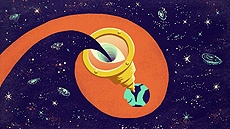Complex simulations: a driving force for LSST
 |
The Large Synoptic Survey Telescope, the world's largest sky survey, will rain a monsoon of data onto the astrophysics community. Simulations prepare scientists for the approaching storm. Image: Sandbox Studio
|
Almost a decade remains before the Large Synoptic Survey Telescope sees first light, and construction has yet to begin on most of the telescope's hardware. Even so, astrophysicists are already developing methods for analyzing the rush of data LSST will produce. In a survey this large and this advanced, data management is just as important as cameras and mirrors.
From atop Cerro Pachón ridge in Chile, LSST will conduct the world's most ambitious astronomical imaging survey yet. Astronomy surveys have been generating catalogs of data since the 1940s. They help scientists study the universe on a large scale and collect vast amounts of data more quickly than it would take with individual observations. LSST will compile a catalog that dwarfs all current survey catalogs combined.
A tribute to advanced technology, the telescope's powerful camera will capture light from objects 100 times fainter than those observed in any current survey, giving scientists a peek into the earliest developmental stages of the universe. The unique, triple-mirror system will scan the entire southern sky in three nights, faster than any other telescope. And each night, the telescope will collect about 15 terabytes of data. The Sloan Digital Sky Survey, the largest optical survey to date, took 10 years to gather the same amount.
All of this data will allow scientists to create a detailed three-dimensional map of our universe and address four main science goals: to explore dark energy, to investigate galactic structure, to monitor objects' movements on short timescales and to track near-Earth asteroids.
To handle the gargantuan quantity of data from the moment the telescope first turns on around 2020, a complex system of computer simulations is already well underway. The system has three principle components: the Image Simulator, which will produce mock LSST images to anticipate image quality; the Operations Simulator, which will predict the optimal viewing schedule each night; and the Calibrations Simulator, which will calculate the true brightness of objects to ensure accurate science. Combined, the simulators will help scientists get as much science as possible from LSST data.
For astrophysicists, the LSST simulators are more comprehensive than any before. Such sophisticated simulations were, until recently, primarily used in particle and high-energy physics research.
"In a particle accelerator, you have a gazillion particles coming out with jets, tracks and lots more," says Fermilab scientist and LSST collaborator Scott Dodelson. "Similarly with LSST, things are becoming very crowded as we go deeper, so we need sophisticated algorithms to even be able to identify what a galaxy is, and we need to test these algorithms with simulations."
Each simulator serves a different purpose, but all are inherently connected and necessary for LSST's future success.
Read more
—Jessica Orwig
|